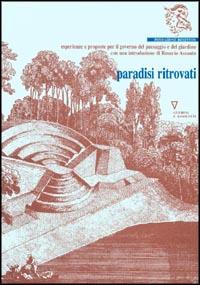
Paradisi ritrovati
Esperienze e proposte per il governo del paesaggio e del giardino
edited by Mariapia Cunico and Domenico Luciani
with an introduction by Rosario Assunto
Fondazione Benetton Studi Ricerche-Guerini e Associati
Treviso-Milan 1991
256 pages, 33 illustrations in colour and 152 black and white
cover price 32 euros
ISBN 88-7802-270-5
(Memorie, 2)
[Paradises regained. Experiences and proposals for the stewardship of landscape and gardens]
The volume gathers together the materials of the first seminar on the management of landscape and gardens held by the Benetton Foundation at Asolo (Treviso) from 27th August to 12th September 1990. Forty experts from all over the world, including scientists, historians, philologists, landscape architects and economists, met for two weeks in the house of Freya Stark. They described their experiences and discussed their proposals for the study and management of parks and gardens, public and private. A wide-ranging survey was dedicated to the arts and sciences useful for the stewardship of landscape. Participants to this debate included Margherita Azzi Visentini (for the philological and historiographical aspect), Pier Fausto Bagatti Valsecchi and Patrizio Giulini (from the viewpoint of conservation and stewardship), Paolo Leon (from that of the economic aspects), Ippolito Pizzetti (for questions of taste and project) and Thomas Wright (on maintenance and renewal). The analysis of over twenty specific situations (six in the United Kingdom, six in Italy, five in France, one in Spain, one in Portugal and two in the USA), re-ordered according to management types (public, private, mixed), helped to elucidate the specific problems, according to the parameter of “stewardship” which, as emphasized by Domenico Luciani in his afterword, characterises the scientific work of the Fondazione Benetton Studi Ricerche in the vast domain of landscape and gardens. The cases examined, ranging from Vaux-Le-Vicomte to Central Park, show how complex is the task of understanding their history, grasping their fundamental characteristics, and managing their unstoppable and continuous evolution. In analyzing the relations between memory and project, between conservation and innovation, between forms of specialization and those of synthesis and coordination, we encounter contradictions of particular acuteness in the stewardship of landscape and gardens which make it all the more necessary to combine good intentions, ideas, know-how and close operational attention. All the sensibilities of which we are capable are revealed in many different facets in this field and interact with each other in the bid to create widely-shared critical insights into the environment, nature, and landscape; and thus enable many to cross the threshold and enter a garden, not only to respect it, but to get to know it and contemplate it, just as one contemplates the “places in which feelings and thoughts become themselves an expression of place”. The volume is opened, with his usual scientific and moral authority, by Rosario Assunto: his introduction, at once high-minded and ironic, is the testimony of a thinker who, alone in the contemporary world, has grappled with the ethical and aesthetic values of landscape and gardens in such a way as to create the presuppositions of the public and private commitment to their understanding and conservation. It is to Rosario Assunto, and the half-century of his implacable battle of ideas, that the Fondazione Benetton dedicated the International Carlo Scarpa Prize for Gardens in 1991.
Contents
Rosario Assunto, Il giardinaggio come operazione filosofica, 7
I. Arti e scienze per il governo del giardino
Margherita Azzi Visentini, Fonti per lo studio dei giardini, 15
Pier Fausto Bagatti Valsecchi, Sui problemi della gestione, 33
Patrizio Giulini, Le cure del patrimonio vegetale, 37
Paolo Leon, L’economia del giardino, 49
Ippolito Pizzetti, Giardini e giardinieri, 53
Thomas Wright, L’esperienza britannica, 57
II. Esperienze di gestione pubblica
Jean-Noël Burte, Il Luxembourg da giardino reale a giardino pubblico, 67
Francesco Decembrini, Merano e la sua Stadtgärtnerei, 73
Mark Flanagan, Wakehurst Place, sede staccata dei Kew Gardens, 77
Nicoletta Furno, Parco Burcina, riserva naturale speciale, 83
Christopher M. Greene, Il futuro dei parchi di F.L. Olmsted nel Massachusetts, 91
Nicole Le Nevez, Il parco orientale di Maulévrier, 101
John D. Main, Edimburgo: Royal Botanic Garden, 105
Timothy Marshall, Central Park. Origine, declino e rinascita, p. 113
III. Esperienze di gestione privata
Patrice Fustier, Courson, parco romantico, 125
Nicolò Giusti, Il governo del mio giardino in Verona, 131
Robert A. Pullin, Hever Castle, 137
Emilio Trabella, Giardini a lago e parco di Villa d’Este, 145
IV. Associazioni e Fondazioni
Teresa Andresen, Serralves e l’arte del giardino nel Novecento, 155
Paolo Cottini, Il Parco Mylius-Vigoni, 161
John D. Main, Wisley: il giardino della Royal Horticultural Society, 167
Lauro Marchetti, Ninfa, giardini e rovine, 173
James M. Marshall, Il National Trust, 183
V. Ritrovamenti e avventure
Carmen Añón Feliu, Scuola laboratorio Alameda de Osuna, 189
Olivier Choppin De Janvry, Désert de Retz, l’avventura di un ritrovamento, 197
Charles Clive-Ponsoby-Fane, Brympton d’Evercy, 211
Patrice De Vogüé, Vaux-le-Vicomte da Le Nôtre a oggi, 217
VI. Postfazione
Domenico Luciani, L’auctoritas necessaria, 231
VII. Indici e referenze
Referenze sugli autori, 241
Referenze sui siti, 243
Indice dei nomi e dei luoghi, 245
